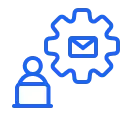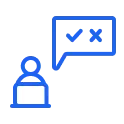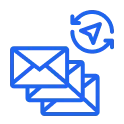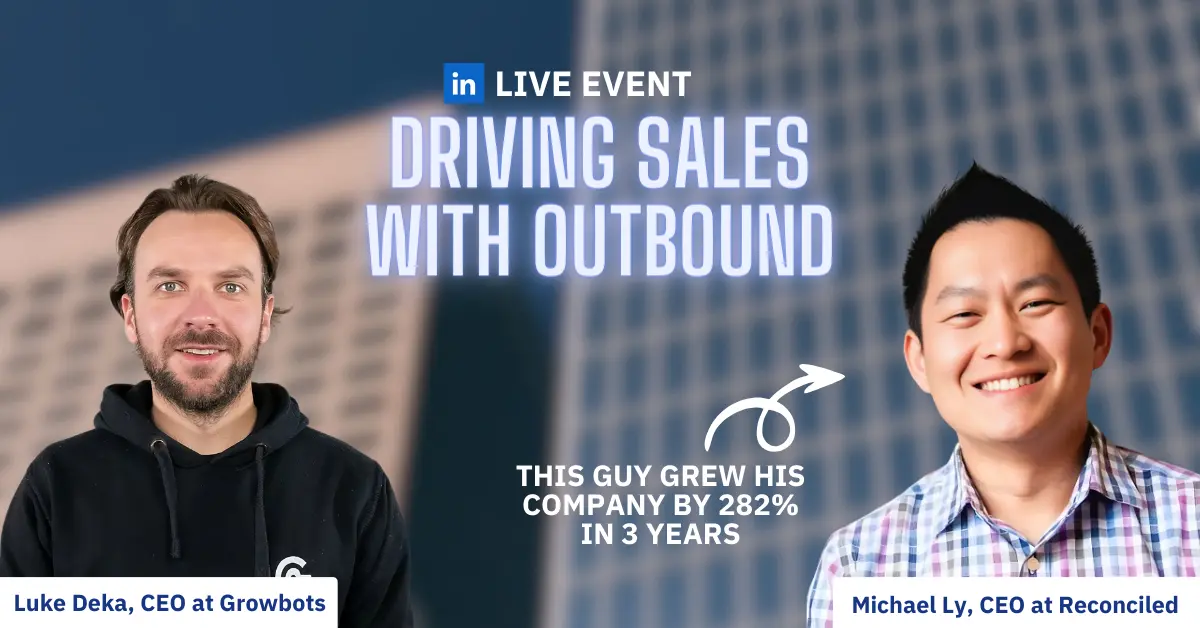How to Write a Killer Email Campaign – Timing your Follow-up email
When it comes to cold mailing campaigns, the follow-up email is where you make the sale. Your first message can be pretty hit or miss, but your follow-up email is your best chance to show the value you offer and convert the prospect, so you need to make sure your email is a true masterpiece. But even the biggest effort can be wasted if you start on the wrong foot or are not persistent enough.
Your follow up email marketing campaign can make or break your connection with a lead, so you want to make it as impactful as possible while slowly releasing more information about your product or services with each email.
Follow up email marketing can feel stressful and overwhelming. I’ll be honest, there is a very fine line you must walk between being a persistent salesperson and being a spammer; however, when you know how to properly create and execute a campaign, you can potentially receive thousands of leads.
When you know how to properly create and execute a campaign, you can potentially generate thousands of leads.
To make sure that you squeeze the most out of each prospect you need to remember about three things: timing, follow-up emails, and outreach strategy. And here we come with the second instalment of our email campaign series!
Things to Remember About Cold Email Follow Ups
Your first follow-up email should continue the chain of communication. As a good salesperson, you need to be persistent. You need to show your prospects that you believe in the value you provide and know they will benefit from it.
In fact, 70% of salespeople end communication if they don’t get a response to the first email they send out. You might be thinking that’s just good business. Afterall, you don’t want to spam your contacts.
In reality, 21% of potential leads who didn’t respond to the first email will respond to the second. Surely you shouldn’t send a third?
Actually, there’s a 25% chance that you will hear back from a recipient if you keep sending cold email follow ups.
21% of potential leads who didn’t respond to the first email will respond to the second. There’s a 25% chance you’ll hear back from a recipient if you keep sending after that.
This doesn’t mean you should spam someone with emails (I’ll go into this more later), but by sending regular follow ups, the chances are you will eventually receive some sort of response. Some people don’t respond until they’re in the market for your product while others simply need a couple reminders. In fact, it takes the average salesperson five attempts before closing the sale.
That’s why you must remember not to show your hand at the start. Here are a few successful follow-up strategies:
Pitch them. Show another angle of your product that answers another one of their problems. It should:
- Be slightly different than the first message.
- Show various benefits of your product.
- Be short and to the point but stay relevant to your message.
- Use action verbs to gently but firmly push the lead to take action on your email.
Remind the prospect about your previous messages. Your emails might’ve gotten lost in their inbox. Don’t let bad timing ruin your conversion.
- Use a short message to move you up in your prospect’s inbox and remind them about your offer.
- Be polite but assertive.
- You can add a link to your article but be sure it is something valuable for your recipient and relevant to your messages.
Tease & give them something they want. Show the potential value for your prospect by offering them a trial account or teaser of your services. Let them see how they will benefit from your solution before purchasing.
Not every contacted person will be up for your offer and most of them won’t even reply to your messages. That’s why you need to add a breakup email at the end of your thread.
- Leave only two options – It’s a ‘take it or leave it’ situation. So ask the recipient directly whether they are interested and want to see your offer and if not, ask them to tell you so that you won’t message them again.
- You can add one more killer pitch here (if you haven’t used it before).

Timing the follow-up email: delivery
It’s not only what you write that matters but also when you deliver it. This is crucial because you can still end up at the bottom of the pile of emails after all your painstaking effort to craft the perfect message .
Keep in mind a few facts:
- Choose random hours – For example, 8:37 looks much more natural than 8:00. Remember that you want your email to look like they were sent to a friend.
- Send in the morning – You’ll end up on top of their inbox when they check their email after arriving at work. Most people start their day reading emails, so why not add yours to their list?
- Don’t send during lunchtime – Lunchtime is not a good idea but sending after 2pm can get a decent open rate due to many people killing time before they go home.
- Don’t discount Sundays – It may seem counterintuitive, but Sunday evenings work exceptionally well – the weekend is nearly over and most of us start to think about work and plan our next week by checking our inbox.
- Try a few different approaches – In order to know which method works best for which target you must test different times of day. People have different working habits so try and think when they’ll be the most responsive (entrepreneurs are probably online 24/7, people in big corporations may be only available 9-5)
Key Take-aways: Choose random hours, send in the morning, don’t send during lunchtime, don’t discount Sundays, and try different approaches
Timing the follow-up email: Which day is best?
- Monday – This is an okay choice because many people plan their whole week and may add you to their calendars. But they may also have a lot of things to run through to catch up after the weekend. You need to test this one out.
- Tuesday/Wednesday/Thursday – This is your best shot. People are most focused during the middle of the week and have gotten caught up on Monday.
- Friday – Friday is not for follow ups. People are already thinking about the weekend and focusing on closing things they planned for the week. Avoid sending first messages then, a soft follow-up email may be a good idea.
- Saturday/Sunday – Saturday doesn’t seem to be a good idea, as the weekend has just begun, but Sunday evenings can convert well.
The best days for sending (follow-up) sales emails seem to be Tuesday, Wednesday, and Thursdays.
Just like in the first message, you need to take care of proper timing of your follow ups.
- Instant follow up – Send a one-line addition a few minutes or hours after the first message. Make it casual, just like you forgot to mention something.
- Keep at least two-day-gap between messages – You don’t want to end up being labeled as a spammer.
- Try different days of the week and different hours – This way you give yourself better chances to hunt the prospect on their daily email checkup.
- Think long term – Don’t bombard your prospect with five messages in one week and then stop. Plan the whole campaign for at least two to three weeks instead and if you still haven’t heard back, remind them about your offer a few weeks later.
Don’t bombard your prospect with five messages in one week – time your campaigns right and test different intervals between messages.
Direct vs referral pitch in your follow-up email
That’s the question you need to ask when you’re defining your target and campaign approach. There is no universal answer for this- just like with everything else in cold mailing you need to test it until you see results.
- Big companies – In many cases you can’t tell for sure who is responsible for a certain business function (i.e. in our case it can be Sales, Marketing or Business Development) and it’s good to ask for referrals (or intros from higher executives).
- Startups and small companies – Most decisions are run through CEO and executives so you should try a direct pitch.
Personally Write Follow Ups or Email Follow Up Bot?
We’re going to start by saying that both methods have their high and low points. If you are interested in purchasing an email follow up bot plan, there are a number of reputable sites available. Many companies find them exceedingly helpful for more casual follow up email marketing while people are put in charge of warm leads. Some things to consider when weighing both options include:
Bots are More Thorough – If you have a variety of free downloads on your site that require an email input to receive, email follow up bots will hit every responder with a reply email, with most companies opting for an instantaneous response, and can keep sending emails to close the sale. Bots are almost always set to include a human representative on each email as well, so all responses put the lead in contact with a living, breathing person.
People’s Emails are More Personalised – When you use a follow up bot, you’re entrusting it to send the same reply to a multitude of people. While there’s nothing wrong with this in theory, when you entrust an employee with email outreach follow up, you can craft a personal response that reflects where your company and lead are in their careers. Personally written responses also allow you to send your emails to certain leads on times and days when they are more likely to respond (this is especially important for those attempting to make international connections).
Bots Can Streamline Your Sales Process – Because bots facilitate more lead potentials, they can provide you with hundreds of contacts and send out thousands of emails a week. This allows you to connect with more people who are actually interested in your product or service and receive actual qualified leads you can expand upon. Because follow up bots send so many emails, they can make those necessary five connection emails with your potential leads much quicker and in a more organised fashion than a person attempting to connect.
In need of a streamlined sales process while keeping the perfect balance between personalised emails and automated follow-ups? Try our all-in-one lead generation platform today.
People Can Meet a Lead’s Personal Needs – Because humans are able to customize the email outreach follow up experience, they can meet the lead’s needs and answer any questions they may have. At the end of the day, bots need humans to make the personal connection to actually close the sale via cold email follow up. Because of this, many companies will opt for a response bot to only respond to sign-up form submissions while people are in charge of traditional cold emailing. The choice is up to you.
Bots are Cheap – There’s no way around this one; bots are significantly cheaper than employees. A single person can effectively send out roughly 100 emails a day to prospective leads (more if they have a template they use) while bots can send millions in a few minutes. The only thing you need to do is craft a message and hit send, with most bots automatically inputting first and last names.
People Aren’t Stopped by Spam Filters – Spam filtering software is becoming more and more advanced, and many companies are finding that potential leads simply do not receive their emails. This can lead to employees wasting time composing general follow up messaging and manually adding lead’s email addresses only for it to wind up in a spam folder, never to be seen again. Personal emails, on the other hand, will almost always go directly into a person’s inbox, meaning there’s actually a chance the email will be read by the recipient.
Wow, that was a lot; yet, it’s still just the tip of the iceberg to crafting a successful cold email marketing campaign.
Key takeaways for follow up email marketing:
- Keep it casual
- Don’t sell, get in touch
- Stress Benefits over features
- The shorter the better
And one last thing, don’t get discouraged by poor results early on. After a few attempts and continually testing, you will get to the point where you’ll be able to read your prospects and answer their questions before they ask.























